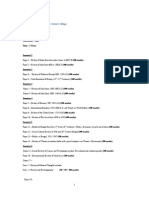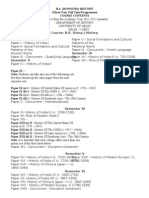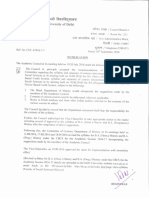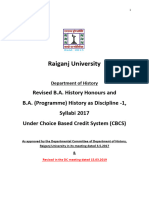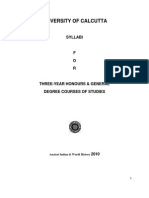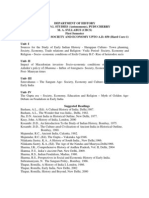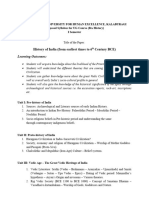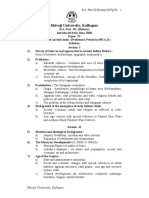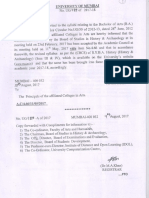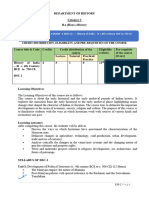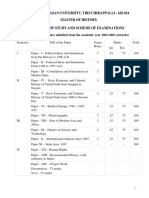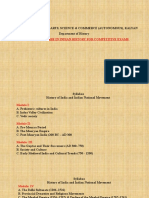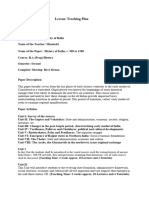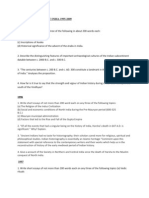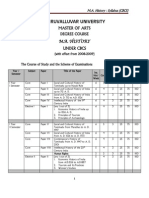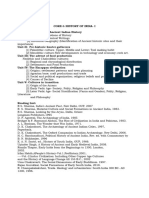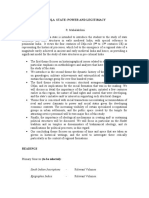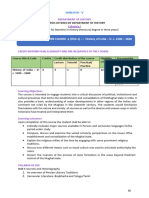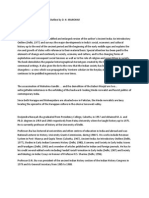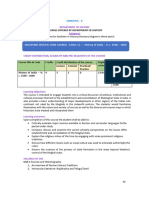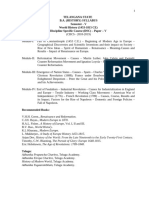University of Calcutta: Syllabi
University of Calcutta: Syllabi
Uploaded by
bhokachodaCopyright:
Available Formats
University of Calcutta: Syllabi
University of Calcutta: Syllabi
Uploaded by
bhokachodaOriginal Title
Copyright
Available Formats
Share this document
Did you find this document useful?
Is this content inappropriate?
Copyright:
Available Formats
University of Calcutta: Syllabi
University of Calcutta: Syllabi
Uploaded by
bhokachodaCopyright:
Available Formats
UNIVERSITY OF CALCUTTA
SYLLABI
F
O
R
THREE-YEAR HONOURS & GENERAL
DEGREE COURSES OF STUDIES
HISTORY
2010
B.A.HONOURSCOURSEOFSTUDIESINHISTORY
DivisionofpapersfortheUndergraduateHonourscourseinHistory
PartI
1. HistoryofIndiafromtheearliestTimesto600CE[ExistingPaperI]
2. HistoryofIndiafromC600toC1500[ExistingPaperII]
PartII
3. TransformationofEurope(15
th
17
th
Centuries)[ExistingPaperIII]
4. HistoryofIndiafromC1500toC1800[ExistingPaperV]
PartIII
5. (GroupA)HistoryofEastAsiafrom1839to1950
OR
(GroupB)AspectsofAntiquity[ExistingPaperIV]
6. HistoryofIndiafromC1800to1964[ExistingPaperII]
7. HistoryofEuropefrom1789to1919[ExistingPaperVII]
8. WorldPoliticsinthe20
th
Centuryfrom1919toC2000[ExistingPaperVIII]
PARTI
PAPER-I
HistoryofIndiafromtheearliestTimesto600CE
UNIT-I (50 marks; 40 lectures)
Module-I
Sources of Early Indian History
1.1ClassificationandimportanceofbothLiteraryandArchaeologicalsources
1.2Understandingthenatureofthesourcesforeachperiod
1.3 HistoryandItihasa
Module-II
Changing Relationship between people and landscape, from hunter-gatherers to post
Harappan cultures in the Indian subcontinent
2.1 The importance of understanding archaeological cultures viz a` viz landscape features-
Hunter Gatherers to Early Pastoralists and Agriculturists
2.2 An over view of archaeological cultures in the subcontinent- pre-Mehrgarh , Mehrgarh and
contemporary to Mehrgarh
2.3 Early/Pre Harappan CulturesPrelude to Harappan CivilizationHarappan Civilization theFirst
Urbanization
2.4 Pastoralist/Early agriculturist Cultures contemporary to the Harappan-various Neolithic and
Chalcolithic cultures of the Indian subcontinent
2.5 Decline of the Harappan civilization-Late/Post Harappan Cultures- a) Cemetery H phase, b)
Gandhara Grave phase, c) Lustrous Red Ware.
Module III
The Vedic Corpus and transition to the age of Janapadas and Mahajanapadas
(c.1500BCE-400 BCE)
3.1 Spread of settlements -Political situation
3.2 Aryan Debate
3.3 Archaeological cultures beyond the Vedic milieuOchre coloured pottery, Black &Red
Ware and Painted Grey Ware
3.4Transition from chiefdom to kingdom- the Ganasangha tradition- sixteen mahajanapadas-
Pre-eminence of Magadha
Module-IV
Mauryan & Post Mauryan India (c. 400BCE-300CE)
4.1 Nature and extent of the Mauryan empire
4.2 Asokas Dhamma
4.3 Decline of the Empire - rise of regional power centres in the post Mauryan period.
4.4 Central Asian intervention in north Indian politics focusing on the Indo-Greeks and the
Kushanas
4.5 The Satavahanas and their struggle with the Saka Kshatrapas of western India
4.6 Kings and chieftains the Cheras, Cholas and Pandyas- Sangam literature and archaeological
evidence.
Module- V
The Age of the Guptas (c.300CE 600CE)
5.1 HistoricalsituationofIndiain300CEEmergenceoftheGuptaempire
5.2 TheEmpireinitsmatureformPoliticalachievementsoftherulersdisintegrationofthe
empire
5.3 AdministrativestructureoftheempirewithspecialreferencetoBengal
5.4 NotionofClassicalageandThresholdtimes
5.5 AnintroductiontothecontemporarydynastiesliketheVakatakas,theKadambasetc.,
UNIT-II (50 marks; 40 lectures)
Module-I
Aspects of Society
1.1 BeginningoftheVarnahierarchyintheVedicperiodformsofmarriage
positionofwomen
1.2 VarnaandJatipropertyrightsofwomen
1.3 Slavery,Untouchabilityandattitudetowardswomen
Module-II
Religious Development
2.1 Vedic religionChanging notion of gods and goddesses-Sacrificial
practices
2.2 Riseofnewreligiousgroups&philosophicalthoughtsBuddhism,
JainismandphilosophyoftheAjivikasandCharvakas
2.3 DoctrinalandphilosophicalChangesinBuddhismandJainismRising
ImportanceoftheBrahmanicalreligionDifferentBrahmanicalreligiousgroups.
Module III
Comparative Structures of Economies in some early states-Maurya- Satavahana-Kushana-
Gupta
3.1 Introduction
3.2 Agrarianeconomy
3.3 Nonagriculturalproductioncraftsguilds
3.4 Monetization
3.5 Landgrantsanditspoliticoeconomicsignificance(Guptaperiod)
Module-IV
Patterns of Trade, Urbanization & Routes of communication
4.1 Trade and Urban development-Second urbanization
4.2Tradingnetworksbothinlandandmaritime(withspecialreferenceto
linkagewithRomanEmpireaswellasSoutheastAsiancountries)
4.3 MerchantsandMarkets
Module-V
Cultural life
5.1 Languages and Scripts An overview
5.2 NatureofMauryanartPresenceofdifferentschoolsofsculptureand
terracottaartinthepostMauryanperiod
5.3 DifferentkindsofReligiousArchitecture,SculpturalartandPaintingan
overview
5.4 SystemsofknowledgeScience,Technology&Medicine
Suggested Readings
A.L.Basham, The Wonder That Was India, London, 1954.
Irfan Habib (general editor), A Peoples History of India (Relevant volumes), New Delhi.
Vol. 1 Pre-history,
Vol. 2 The Indus Civilisation,
Vol. 3 The Vedic Age,
D.N.Jha, Ancient India: An Introduction, New Delhi, 1998.
D.D.Kosambi, An Introduction to the Study of Indian History, Bombay, 1956.
------------------ Combined Methods in Indology and Other Writings, Edited and Introduced by
B.D.Chattopadhyaya., 2007 (revised edition)
R.C.Majumdar (general editor), The History & Culture of the Indian People, volumes I-III,
Bombay, 1951, 1968,1970
Shireen Ratnagar, Understanding Harappa, Delhi, 2001.
Nihar Ranjan Ray, Brajadulal Chattopadhyaya, V.R. Mani and Ranabir Chakravarti eds. A
Source Book of Indian Civilization, Kolkata, 2000.
H.C. Raychaudhuri, Political History of Ancient India with a commentary by
B.N.Mukherjee, New Delhi, 1996 (8
th
edition)
R.S.Sharma,IndiasAncientPast,NewDelhi,2005.
Upinder Singh. A History of Ancient and Early Medieval India. Delhi, 2008.
Romila Thapar, Early India: From the Origins to AD 1300, London, 2002.
Asvini Agarwal, The Rise and Fall of the Imperial Guptas, New Delhi, 1988.
D.P.Agarwal, The Archaeology of India, London, 1982.
F.R. Allchin (ed). The Archaeology of Early Historic South Asia: The Emergence of Cities and
States, Cambridge, 1995.
A.S.Altekar, The Position of Women in Hindu Civilization from Pre-historic times to the Present
Day, New Delhi, 1962.
A.L.Basham ed. A Cultural History of India, New Delhi, 1975.
Sukumari Bhattacharji. Women and Society in Ancient India. Calcutta, 1994.
Dilip Kumar Chakrabarti, India, An Archaeological History, Delhi, 1999
------------------------------An Oxford Companion to Indian Archaeology, New Delhi, 2006.
Uma Chakravarti. The Social Dimensions of Buddhism. New Delhi: Oxford University Press,
1987.
-------------------------, Trade and Traders in Early Indian Society, New Delhi, 2007 (revised
edition)
R.Champakalakshmi, Trade, Ideology and Urbanization: South India : 300BC to AD 1300,
Delhi, 1996.
D. Chanana, Slavery in Ancient India as Depicted in Pali and Sanskrit Texts, Delhi, 1960.
B.D. Chattopadhyaya. Studying Early India: Archaeology, Texts and Historical Issues. New
Delhi, 2003.
D.P.Chattopadhyay, Science and Society in Ancient India, Calcutta, 1977.
George Erdosy, Urbanization in Early Historic India, Oxford, 1988.
Amalananda Ghosh, The City in Early Historic India, Shimla, 1973.
R. Kochar, The Vedic People, New Delhi, 2000.
Nayanjyot Lahiri, The Decline and Fall of the Indus Civilization, New Delhi, 2000.
R.C.Majumdar and A.S.Altekar eds. The Vakataka Gupta Age, Varanasi, 1955.
George Michell. The Penguin Guide to the Monuments of India. London, 1989.
B.N.Mukherjee, The Rise and Fall of the Kushana Empire, Calcutta, 1989.
---------------------The Character of the Maurya Empire, Kolkata, 2000
----------------------Kushana Studies, New Perspectives, Kolkata, 2004
Sheldon Pollock. The Language of the Gods in the World of Men. Sanskrit, Culture and Power in
Premodern India. New Delhi, 2006.
G.L. Possehl, ed. Harappan Civilization- A Recent Perspective, Delhi, 1993 (second edition).
Shereen Ratnagar, The End of the Great Harappan Tradition, Delhi, 2000
Kumkum Roy, The Emergence of Monarchy in North India: eighth to fourth centuries BC, New
Delhi, 1994
(ed), Women in Early Indian Societies. New Delhi, 1999.
Nihar Ranjan Ray, Maurya and Post Maurya Art, New Delhi, 1975.
Bhairabi Prasad Sahu (ed.). Iron and Social Change in Early India. New Delhi: Oxford
University Press, 2006.
Richard Salomon. Indian Epigraphy: A Guide to the Study of Inscriptions in Sanskrit, Prakrit,
and Other Indo-Aryan Languages. New York, 1998.
S.K.Saraswati, A Survey of Indian Sculpture, New Delhi, 1975 (second edition)
R.S.Sharma, Perspectives in the Social and Economic History of Early India, New Delhi, 1983.
.
---------------Material Cultures and Social Formations in Ancient India, New Delhi, 1983.
----------- Aspects of Political Ideas and Institutions in Ancient India. New Delhi, 2005 (reprint).
Early Medieval Indian Society: A Study in Feudalisation, Delhi, 2001.
Indian Feudalism, University of Calcutta, 1965.
Looking for the Aryans, 1995.
Advent of the Aryans, Manohar, 1999.
Sudras in Ancient India.
A.M.Shastri ed. The Age of the Vakatakas, Delhi, 1992.
K.A. Nilakantha Shastri, A History of South India, Madras, 1974 (4
th
edition)
D.C. Sircar, Indian Epigraphy, New Delhi, 1965.
Bardwell Smith ed., Essays in Gupta Culture, New Delhi, 1983
Frits Staal, Discovering the Vedas: Origins, Mantras, Rituals, Insights, New Delhi, 2008.
Romila Thapar. The Mauryas Revisited. Calcutta, 1987.
------------------From Lineage to State, Delhi, 1996 (2
nd
edition).
------------ Asoka and the Decline of the Mauryas. New Delhi, 2000.
Romila Thapar (et. al). India: Historical Beginnings and the Concept of the Aryan. New
Delhi, 2006.
T.R. Trautmann (ed). The Aryan Debate. New Delhi, 2005.
=.=.<-, <|<< $ <<<, (TheWonderThatWasIndia) |< <|,
++<, ~.
<+<|< <<|, <<< :|<>< |- <, ++<, ~-.
:<+- >|<<, <<<<< <<+ --< :|<>
- : +-:|<>, (Prehistory)=-.|<.=, ++<, ~~
|<| : |+ <<, (TheIndusCivilisation)=-.|<.=, ++<, ~~.
<<| : (<|-+ <<, (TheVedicAge)=-.|<.=, ++<
|.=-.|- <<<: =+|| |r :|<>, (AncientIndia:AnIntroduction),
|< <|, ++<.
|.|. +|, <<< :|<> < <|-+, (AnIntroductiontotheStudyofIndianHistory) +
|, <| =~ +, ++<, ~~.
||<- <<<>< <<< +-, (UnderstandingHarappa),=-.|<.=, ++<, ~:
>-- <|<<|,|- <<<< <<(-|<+ :|<>, (PoliticalHistoryofAncientIndia)
|-< << + <, ++<
<|- <, <<<<< :|<>, <|<| --, ++<
-<-- <, |- <<< <-, ++<, ::tt
-<-- <,|- <<<| -<, |-< << + <, ++<
+-<| <,:|<>< + (<|-+ |><, |-< << + <, ++<
+-<| <,|- <<< : -< < |><, -- <|, ++<
|-| +-< <<|- <<<<< + :|<>, -- <|, ++<,::::
<+<|< <<|,|- <<<< (-|<+ :|<>< +-, -- <|, ++<,
~~ (|<< <+).
-<<< --, |- <<< - , (SlaveryinAncientIndiaasDepictedinPaliandSanskrit
Texts),+ |, <| =~ +, ++<, :::.
-|>< <- <, <c|< :|<>, ++<, ::t (|<| <+)
<-<+ -,|- <<<< (-|<+ < -|<+ :|<>, (PerspectivesintheSocialand
EconomicHistoryofEarlyIndia), <|<| --, :::
<-<+ -,|- <<< << |< < -< `-,(MaterialCulturesandSocial
FormationsinAncientIndia), <|<| --, :::t
<-<+ -,|- -<< <<<| -< : --| |< =+ -|, (EarlyMedieval
IndianSociety:AStudyinFeudalisation),<|<| --, ~:
<-<+ -,<<<< -<, (IndianFeudalism),+ |, <| =~ +, ++<
<-<+ -,-< -+-, (LookingfortheAryans), |< <|, ++<
<-<+ -,-< <<< --,(AdventoftheAryans), <|<| --, ~:
<-<+ -,|- <<< a, (SudrasinAncientIndia), + |, <| =~ +, ++<
<|- <,+ < -|-< <-,(AsokaandtheDeclineoftheMauryas), + |, <|
=~ +, ++<
-| <, |- <<<< :|<> (:- ), |-< << + <,
=+- -a+ : =| ~s
-| <, |- <<<< :|<> (~ ), |-< << + <, t- -a+ :
+<|< ~s
>|<-- - <, <<<<< :|<> (:- )(|- < -<), |-< <<
+ <,:- -a+ : -<< :::-.
--| |<<|, |<-| |+ < <<- <-< <+- <<<, |-< << + <,
| ::ts.
PAPER II
HistoryofIndiafromC600toC1500
UNIT I c AD 600 - 1200 (50 marks; 40 lectures)
Module 1.
1.1 Sources & their interpretation: Inscriptions, Literature, Architectural Monuments &
Sculpture, Coins
1.2 Historiography & Recent Debates (Periodisation / Feudalism / Segmentary State)
Module 2. Polity
2.1 Emergence of major political centres c 600 - 650: Kanauj, Bengal, Peninsular India
2.2 Political developments c 650 1200: Bengal, Western India, Peninsular India
2.3 Arab, Ghaznavid and Ghorid invasions: nature and impact
Module 3. Economy
3.1 Agricultural Expansion: Land grants and irrigation/agricultural technology
3.2 Land tenure: nature and changes
3.3 Urban centres: urban processes and population increase
3.4Crafts and guilds
3.4 Indian and oceanic trade: a broad overview of trade linkages and commodities
Module 4. Society
4.1 Varna-Jati: the proliferation of castes
4.2 Gender relations: property rights; forms of marriage; attitudes towards women; women
saints
Module 5. Culture & Religion
5.1 Sanskrit Literature; Evolution of literature in regional language with special reference to
Bengali
5.2 Systems of knowledge: Schools of philosophy an overview; Science:Mathematics,
Astronomy
5.3 Temple and Cave Architecture; Sculpture
5.4 Overview of main religious sects: Buddhist, Vaishnavite, Shaivite, Bhakti
UNIT II c 600 1500 (50 marks; 40 lectures)
Module 1.
Survey of sources and historiography with special reference to Barani, Amir Khusrau and Ibn
Batuta
Module 2. Polity & Institutional Structure [1206-1290;1290-1350;1350-1500]
2.1 The state in Northern India and the response to challenges
2.2 Legitimacy, Sovereignty and theories of kingship
2.3 Nature and composition of ruling groups and the consolidation of the authority of the
Crown
2.4 Patterns of regional political formations in Eastern and Peninsular India: Bengal;
Vijaynagar & Bahmani kingdoms
2.3 Evolution of iqta and amaranayaka / nayankara systems
Module 3 Economy
3.1 Agrarian economy of the Delhi Sultanate: agricultural production and pattern of land
tenure
3.2 Revenue system and magnitude of taxation
3.3 Urban processes and non-agricultural production
3.4 Monetary system, market regulations and trade during the Sultanate period
3.5 Peninsular India Expansion of agricultural frontiers; incidence of taxation; long-distance
trade and the role of the state
Module 4 Society
4.1 Composition of rural society and the village community
4.2 Forms of dominance and resistance slavery, peasant uprisings in North India;
militarization of peasant society in Peninsular India.
Module 5. Culture & Religion
5.1 Literature : Persian, and literature in regional languages with special reference to Bengali
literature
5.2 Architecture: Forms & Function Sultanate & Provincial with special reference to Bengal
5.3 Sufism : origins, precepts, practices
5.4 Bhakti : Kabir, Nanak, Chaitanya
5.5 Science & Technology: Irrigation, Agricultural technology; Building techniques; Textile
production
Suggested Readings
Ashraf, K.M. Life and Conditions of the People of Hindustan (1250-1550)
Basham, A.L The Wonder that was India
Basham, A.L (ed) A Cultural History of India
Bose Mandakranta (ed) Faces of Feminine in Ancient Medieval and Modern India
(NewYork, 2000)
Chakravarti, R(ed) Trade in Early India (Delhi)
Champakalakshmi, R Trade, Ideology and Urbanisation : South India 300 BC AD 1300
(Delhi 1996)
Chandra, S History of Medieval India (800 1700)
Chattopadyay, B.D The Making of Early Medieval India. (Delhi, 1994)
Chattopadyay, B.D Aspects of Rural Settlements and Rural Society in Early Medieval
India
Chattopadyay, B.D Studying Early India: Archaeology, Texts and Historical Issues
(New Delhi, 2003)
Chattopadyay, D.P Science and Society in Ancient India (Calcutta, 1977)
Chaudhuri, K.N. Trade and Civilisation in the Indian Ocean. An Economic History
from the Rise of Islam to 1750
Eaton, R.M. The Rise of Islam & the Bengal Frontier (1204 1760)
Gopal Lalanji The Economic Life of Northern India (Varanasi, 1965)
Habib, Md. And Nizami KA (eds) A Comprehensive History of India Vol. V
Habib, Irfan Medieval India: The Study of a Civilisation (New Delhi, 2008)
Habib, Irfan Economic History of Medieval India: A Survey, (New Delhi, 2001).
Habibullah, A.B.M The Foundation of Muslim Rule in India
Jackson, Peter The Delhi Sultanate: A Political & Military History (Camb, 1999)
Jha D.N (ed) The Feudal Order (New Delhi, 2000)
Karashima, N. South Indian History and Society : Studies from inscriptions
Towards a New Formation : South Indian Society under Vijaynagar
Kulke, H. (ed) The State in India (1000 1700)
Kumar Sunil The Emergence of the Sultanate of Delhi
Majumdar R.C. et al (eds) History and Culture of the Indian People Vol. IV and Vol. V
Majumdar R.C and Dasgupta K.K.
(eds)
A Comprehensive History of India Vol. III
Meister M.M & Dhaky M.A Indian Temple Architecture (Delhi, 1983)
Mukherjee B.N Post-Gupta Coinages of Bengal (Calcutta, 1989)
Mukhia, H. (eds) The Feudalism Debate
Nizami, K.A. Some Aspects of Religion and Politics in India in the 13
th
c
Pollock Sheldon The Language of the Gods in the World of Men. Sanskrit, Culture
and Power in Premodern India (New Delhi, 2006)
Ray H.C Dynastic History of Northern India (New Delhi, 1973)
Roy Kumkum (ed) Women in Early Indian Societies (New Delhi, 1999)
Ray Nihar Ranjan et al ed. A Source Book of Indian Civilisation (Kolkata, 2000)
Ramaswami Vijaya Walking Naked: Women,Society, Spirituality in South India (Simla,
1997)
Rizvi, S.A.A. The Wonder that was India, Vol. II
Roychoudhury T.K. & Habib I. (eds) The Cambridge Economic History of India Vol. I
Sastri, K.A. Nilakanta A History of South India from Prehistoric Times to the Fall of
Vijaynagar
Sastri, K.A. Nilakanta (ed) A Comprehensive History of India Vol. II
Sharma, R.S. Indian Feudalism
Sharma, R.S. Early Medieval Indian Society: A Study in Feudalisation (Delhi,
2001)
Shastri K.A.Nilkantha Shastri The Cholas (Madras, 1975 [reprint])
Sherwani, HK & Joshi, PM (eds) The History of Medieval Deccan (1295 1724)
Singh, U A History of Ancient & Early Medieval India
Stein, B Peasant, State & Society in Medieval South India
Thapar, R Early India
Tripathi, R.P Some Aspects of Muslim Administration
Veluthat, K The Political Structure of Early Medieval South India
Yadava, B.N.S. Society & Culture in North India in the 12
th
c
Yazdani, G. (ed) The Early History of the Deccan
+. =-. <+
|>--< <--<|<- < <|<- , (LifeandConditionsofthe
PeopleofHindustan(12501550))
<|, ++<, ::t
=.=.<-, <|<< $ <<<,(TheWonderthatwasIndia),
|< <|, ++<, ~
>|<-- - <, <<<<< :|<> (:- )(|- < -<), |-<
<< + <,:- -a+ : -<< :::-.
-<-- < <- < |< : |- <<<| |
|-|><+-< < <<<< :|<> (<+-+- ), |-< << +
<, ~ -a+ : +<<| :::~.
<+<|< <<| |- <<<< (-|<+ :|<>< +-, --
<|, ++<
<+<|< <<| <<< :|<>< |- <, <|<| --, ++<,
~-
:<+- >|<<, -<< <<<< (-|<+ :|<>, (EconomicHistoryof
MedievalIndia:ASurvey),|< <|, ++<, ~:
:<+- >|<<, (~|-<)
-<+|- <<< :-s ~ (Medieval India), + |, <|
=~ +, ++<.
=. |<. =-. >|<<u> <<< -|- -< |< :~-:~:,(TheFoundation
ofMuslimRuleinIndia), |< <|, ++<
- -<-- |<-< :|<>, ((< +-, :::)
<-<+ - <<<< -<, (IndianFeudalism),+ |, <| =~
+, ++<
<-<+ - |- -<< <<<| -< : --| |< =+
-| (EarlyMedievalIndianSociety:AStudyinFeudalisation)
<|<| --, ~:
|-< < < << <| <, -< << -< < |<, + |, <| =~ +,
++<, :::~
|-< < -<< <<<< :|<> : <|- -, <|<|
--, ++<.
~ +|<-
<< :|<> : <|- -, |+.
PARTII
PAPERIII
TransformationofEurope(15
th
17
th
Centuries)
UNIT-I (50 marks; 40 lectures)
Module 1
1.1 NatureoftheFeudalSocietyanditsregionalvariations
1.2 CrisisofFeudalism
1.3 TransitionDebate.
Module 2
2.1EconomicCrisisandthecommercialdeclineinthe14
th
CenturyEurope
2.2Theurbandecayandtheepidemics.
Module 3
3.1ImpactofthefallofConstantinople.
3.2DevelopmentofNationalMonarchy.
Module 4
4.1Economyinthe15
th
CenturyEurope
4.2EconomicexpansionofEuropeinthe16
th
Century
4.3Protoindustrialisationtheriseofnewmerchants
4.4PriceRevolution
4.5AgriculturalRevolutionandtheEnclosureMovement.
Module 5
5.1PrintingRevolution
5.2Revolutioninwartechniques
5.3Theexplorationofthenewworld
5.4PortugeseandSpanishvoyages.
Module 6
6.1Renaissance
6.2Renaissancehumanism
6.3Rediscoveryofclassics
6.4Italianrenaissanceanditsimpactonart,culture,educationandpoliticalthought
6.5Northernhumanism.
UNIT-II (50 marks; 40 lectures)
Module 1
1.1 Theformationofearlymodernstate
1.2 TheempireofCharlesVofSpain
1.3 NewMonarchyinEngland.
Module 2
2.1Reformationmovements
2.2Origins&courses
2.3MartinLuther&Lutheranism
2.4JohnCalvin&Calvinism
2.5Radicalreformation:AnabaptistsandHuguenots
2.6Englishreformationandtheroleofthestate
2.7CounterReformation.
Module 3
Theeconomyofthe17
th
CenturyEurope.
Module 4
4.1Originsofmodernscience
4.2ScientificRevolution
4.3Emergenceofscientificacademies
4.4OriginsofEnlightenment.
Module 5
5.1PeaceofWestphalia(1648)
5.2EmergenceofmodernEuropeanstatesystem.
Module 6
6.1TheEnglishCivilWarofthe17
th
Century
6.2PoliticalideasoftheCivilWar
6.3TheSettlementof1688andtheideasofJohnLockeandtheconceptofliberalism.
Suggested Readings
1. Anderson, Perry, The lineages of the Absolutist States.
2. Aston, T.H. and Philipin C.H.E. (eds.), The Brenner Debate: Agrarian Class Structure and
Economic Development in Pre-Industrial Europe, Cambridge University Press. 2005.
3. Bernal J.D, Science in History
4. Burke, Peter, The Renaissance.
5. Cameron, Euan (ed), Early Modern Europe: An Oxford History, OUP.
6. Dunn Rechard S., The Age of Religious Wars, 1559-1715, W.W. Norton & Company, 2004.
7. Elton, G.R., Reformation Europe, 1517-1559.
8. Gilmore, M.P., The World of Humanism, 1453-1517.
9. Hale, J.R., Renaissance Europe
10. Hall, R., From Galileo to Newton.
11. Hill, Christopher, A century of Revolutions.
12. Hilton, Rodney, Transition from Feudalism to Capitalism, Aakar Books, 2006.
13. Koenigsberger, H.G. and Mosse, G.L., Europe in the Sixteenth Century.
14. Lee, Stephen J., Aspects of European History, 1494-1789.
15. Owie, L.W., Seventeenth Century Europe.
16. Parker, G. and Smith, L.M., General Crisis of the Seventeenth Century.
17. Pennington, D.H., Seventeenth Century Europe.
18. Rabb, Theodore K., The struggle for Stability in Early Modern Europe.
19. Rice, Eugene F. and Grafton, Anthony, The Foundations of Early Modern Europe, 1460-1559,
W.W. Norton & Company, 2004.
20. The Cambridge Economic History of Europe, Vol. I, IV.
21. The New Cambridge Economic History of Europe, Vol. I, VII.
:. - |`|, :<|< <- <c|< |<, -- <|, ++<,
:::s
~. |- -r, <<< ->< <|+< < <<-||< :-:t, --
<|, ++<, ::::
:. <.|.<-,:|<> |<-,(ScienceinHistory),-- <|,++<,
~
s. -<- - -, |<-< :|<>, (< +-, ++<, :::
. >|a < , :~< :|<> (||$< ),|-< << +
<,++<,:::
. << <<|, < <- <<| =< |+:+ <, :$< <,
-<<<<| +-|, ++<, ~
-. <| -<|, <|<< :$< (: - :t), |< <|, ++<,
~s
PAPERIV
HistoryofIndiafromC1500toC1800
UNIT-I (50 marks; 40 lectures)
Module1:TheMughals
1.1.Historiographyandsources:i)Historiography:differentapproaches;
ii)Anoverviewofsourcesincluding:AbulFazl,Badauni,
Bernier.
Module2:ThefoundationandconsolidationofEmpire
2.1.AbriefoverviewofIndiaontheeveofBabursinvasionkingdomsofDelhi,Mewar,Bengal,Bihar,
Punjab;
2.2Conquestandstability:i)StruggleforEmpireinNorthIndiasignificanceofBaburandHumayuns
reignii)significanceofAfghandespotismandriseofSherShahSurtopowerandhiscontribution.
2.3.Expansionandconsolidationoftheempire:i)makingofanewimperialsystemandadministration
theMughalnobility,mansabandjagir;ii)formationandevolutionoftheMughalrulingclassiii)
NurjahanherroleinimperialpoliticsandthejuntaiV)themansabdarisystemunderShahjahanand
Aurangzebin17
th
century.
2.4.TheMughalsandtheNorthwesternfrontierandCentralAsia.
Module3:IdeologyandStateinMughalIndia
3.1.i)TheTurkoMongoltradition;ii)theAkbariimperialagendaandSuhlikul;iii)Akbarsattitude
towardsreligionandthestate;
3.2.Evolutionofimperialpolicytowardsreligionandstateinthe17
th
century;
3.3.IdeologyofalliancestheMughalsandtheRajputsin16
th
&17
th
centuries.
Module4:EconomyinMughalIndia:Patterns,prospectsandstructure
4.1.Thesystemofagriculturalproductionagriculturaltechnologyandcroppatterns;i)Zabtisystem
magnitudeoflandtax;ii)nonagriculturalproduction;
4.2.Trade,commerceandmonetarysystemi)inlandandoceanictradenetworkinthe17
th
century;ii)
creationofnewtradingcentres;iii)crafts,industriesandorganization;
Module5:CrisisoftheMughalEmpire
5.1.Aurangzeb,theimperialeliteandtheDeccanwars;
5.2.RiseoftheMarathasunderShivaji.
5.3.PopularrevoltswithintheMughalEmpiretheJats,Satnamis,AfghansandtheSikhs;
5.4.CrisisintheJagirdarisystemitspoliticalandeconomicimplications.
UNIT-II (50 marks; 40 lectures)
Module1:SocietyinMughalIndiastructureandgrowth
1.1.Ruralsocietyandagrarianrelations:i)landownershipandnatureoflandrights,ii)zamindarsand
peasantry;
1.2.Urbansociety:i)townsandtownlife,ii)merchantcommunities,artisansandbankers.
Module2:ReligionandcultureinMughalIndia
2.1.Sufism;
2.2.Bhaktimovementinthe17
th
centurytheVaishnavaBhakticultinBengalanditsregional
variations;
2.3.Literature,paintingandarchitecture;
2.4.Technologyanoverviewofmechanicaldevicesintextile,irrigation,military&buildingtechnology.
Module3:DeclineoftheMughals&theEmergenceofSuccessorStates
3.1.InterpretationsonthedeclineoftheMughalEmpire;
3.2.EmergenceoftheregionalpowerscasestudiesofMaharashtra,AwadhandBengal;
3.3.BengalNawabsandtheriseoftheEnglishEastIndiaCo.inBengal;
Module4:ConsolidationofEnglishPower
4.1.TheAngloFrenchrelations;
4.2.Buxar,Diwani;theFamine,DrainofWealth;frameworkofCompanyscontrol(theRegulatingAct,
PittsIndiaAct);thePermanentsettlement.
4.3.CompanysrelationshipwiththeotherIndianpowersMysoreandAwadh.
Module5:Interpretingthe18
th
centuryandtransitiontocolonialism
SuggestedReadings
ForUnit1
Ali,M.Athari)MughalIndia:StudiesinPolity,Ideas,societyandCulture.
ii) The Mughal Nobility under Aurangzeb.
Alam, Muzaffar& Subhramanyam,Sanjay (ed.)-The Mughal state.
Bashir,AhmedAkbar,theMughalEmperor.
Bernier,F.TravelsinMughalIndia.
Chandra, Satish-i) A History of Medieval India (part II)
ii)Historiography,ReligionandStateinMedievalIndia
iii) Parties and Politics at the Mughal Court 1707-1740.
iv) The 18
th
century in India: Its economy and the Role of the Marathas,the Jats and the Sikhs
and the Afghans and Supplement (K.P.Bagchi)
v)Mughal Religious Policies, the Rajputs and the Deccan.
Streusand D.F.-The Formation of the Mughal Empire
Habib Irfan(ed.)-i) Medieval India ii)The Agrarian System of Mughal India(1556-1707).
Mishra, Satish -Rise of Muslim Power in Gujrat( part I)
Raychoudhuri T.K. & Habib I. (eds.)-The Cambridge Economic History of India vol.1
Richards J.F. The Mughal Empire
Gordon S.-The Marathas 16oo-1818
Hasan S. Nurul-Thoughts on Agrarian Relations in Mughal India
Kulke, H.(ed.)The State in India 1000-1700.
Unit2
Alavi,Seema (ed.)-The Eighteenth Century in India
Alam, Muzaffar& Subhramanyam, sanjay (ed.)-The Mughal state.
Alam ,Muzaffar-The Crisis of Empire in Mughal North india:Awadh and Punjab-1707-1748.
Ali,M.Athar- i) The Mughal Nobility Under Aurangzeb, ii)Mughal India: Studies in Polity,
Ideas, society and Culture.
Arasaratnam,S.:Maratime India in the 17th century.
Barnett,R.B-North India between Empires: Awadh, the Mughals and the British.
Bandopadhyay, S- From Plassey to Partition
Bayly,C.A.(i)-Indian Society and the Making of the British Empire; ii) Rulers,Townsmen
&Bazaars, North india in the age of British Expansion 1770-1870.
Bayly, Susan-Caste, Society and Politics in India from the 18th century to the modern age.
Chaudhuri, K.N.-Trade & Civilization: An Economic History from the Rise of Islam to 1750.
Eaton, R.M.-i)The Rise of Islam and the Bengal Frontier 1204-1760;ii) The Sufis of Bijapur
Fukuzawa ,H.-The Medieval Deccan: Peasants, Social systems and States 16
th
to 18
th
centuries.
Gordon S.-The Marathas 16oo-1818
Grewal J.S.-The Sikhs of the Punjab
Habib Irfan- Resistance & Modernization under Haider Ali & Tipu Sultan
Marshall P.J.i)-East Indian Fortunes: the British in Bengal in the 18
th
cent. ii) Bengal the British
Bridgehead iii) (Edited) - The Eighteenth century in Indian history: Evolution or revolution
Nizami K.A.-i) Some Aspects of Religion and Politics in India in the 13
th
century ,ii) (ed.)
Politics and society during the early Medieval Period : The collected Works of Prof. Md. Habib
(2 vols.)
Rizvi S.A.A.-i) The Wonder that was India (vol.2);
ii) A History of Sufism in India
Sarkar, Sir J.N.-i) History of Aurangzeb 5 vols.;ii) The Fall of the Mughal Empire (4 vols.)
Stein, Burton i)Vijayanagara
ii)History of Deccan
iii) Eighteenth Century in India: Another view (Studies in History, No.I, 1989)
iv) Peasant, State and society in Medieval South India (OUP)
Tripathi R.P.-i) The Rise & Fall of the Mughal Empire ii) Some Aspects of Muslim
Administration
Wink, Andre- Land and Sovereignty in India: Agrarian society and politics under the eighteenth
century Maratha Swarajya.
=-.<.|, <<<<< - - |<<< +|, (TheMughalNobilityunder
Aurangzeb) + |, <| =~ +, ++<.
< <-<, s- <+< - +| < <|-+ :|<> |, <+ <,
++<, ::t:.
|<- <a, - +| -||< < ++ |<a>, <+<, ++<, ::t:
<| -, - -<<< - < <<-||<, (PartiesandPoliticsattheMughalCourt17071740),
+ |, <| =~ +, ++<, ::-t.
|<- <+ |<<| , |-<|+ - << +| :|<>, + |, <| =~ +,
++<
|<- <+ |<<| < --<, << +| -<< `-, + |, <| =~ +,
++<
:<+- >|<<, -<+|- <<<, : - s , + |, <| =~ +, ++<
:<+- >|<<, - -< < << <-: =+|| -|, |-< :|<> -, ~
:<+- >|<<- <<<< +| <<, (TheAgrarianSystemofMughalIndia(15561707)), +
|, <| =~ +, ++<
:<+- >|<<,-<< <<<< (-|<+ :|<>, (EconomicHistoryofMedievalIndia:A
Survey),|< <|, ++<, ~:
:<+- >|<<,<<<< :|<> : -+| <-< +, (EssaysinIndianHistory:
TowardsaMarxistPerception) -- <+ =<|, ++<, ::::
:-, |<<- << :|<> |-<|+ -+`- ,|-+, |+, ~~
|-< < - -<< <<<< (-|<+ :|<>, :~-:--, |< <|,
++<
|-< < - - < (-|<+ :|<>, + |, <| =~ +, ++<
<-| -<+ <+<, - -||< : `- =< +-, (MughalEconomy:
OrganisationandWorking) |-< << + -, ++<, ::::.
|||+- - < <|-<<<<<, <|, ++<
>|<-- - <, <<<<< :|<> (~ ~)
(- < |<|| <<<), |-< << + < , ++<, :::t
-+ <<|, |<<-$---| , |-< << + <, ++<, ::t:.
<<<+ <, |< < +< -<, -- <|,++<
| |<<| - |< <- +|>-|, -- <|,++<
<<<| < - - < -<<|< |+
PARTIII
PaperVA
HistoryofEastAsiafrom1839to1950
UNIT I: China (50 marks; 40 lectures)
Module 1
PrecolonialChina
1.1 ThenatureandstructureofthetraditionalChinesesocietythepeasantryandthegentryclass
1.2 Governmentbureaucracyandcentralcontrol
1.3 Chinaspremoderneconomy
Module 2
ColonialPenetrationinChina
2.1Thetributesystem,theCantonsystemandtheircollapse
2.2Opiumwarsandtreatieswithimperialistpowersandstruggleforconcessionsin
China
2.3Increasingwesterneconomicinterestsemergenceofacoastalenclaveeconomyrise
ofcompradorbougeoisieopendoorpolicy
Module 3
PopularMovementswithspecialreferencetoTaipingRevolt
3.1Backgroundandcause
3.2Nature
3.3Causesoffailure
3.4LegacyoftheRevolt
3.5OthernearcontemporaryrebellionsNien,Muslimrebellions(18551874),Miao
insurrection(18501872)
Module 4
Restoration,Reform,Revolution
4.1TungchiRestoration
4.2TheSelfstrengtheningMovement
4.3TheReformMovementof1898iv)BoxerRebellionanditsconsequencesv)Late
ChingReforms(190108)vi)RepublicanRevolutionof1911roleofvarioussocial
classes
4.4SunYatSenprinciplesandpolitics
Module 5
NationalismandCommunisminChina
5.1EmergenceoftheRepublicandYuanShiKai
5.2Warlordism(19161925)
5.3NewIntellectualideasandMayFourthMovementorigin,natureandsignificance
5.4Problemofearlyindustrialisation
5.5Politicalcrisisinthe1920sTheKuomintangsThefirstUnitedFrontThe
KuomintangCommunistConflictTenyearsofNankingGovernment
5.6TheCommunistPartyunderMaoTseTungthemakingoftheRedArmyThe
SecondUnitedFrontLongMarchSecondSinoJapaneseWar(1937)Yenan
experimentTheChineseRevolution(1949)ideology,causesandsignificancethe
EstablishmentofthePeoplesRepublicofChina.
UNIT II: Japan (50 marks; 40 lectures)
Module 1
PreRestorationPeriod
1.1 TheTokugawaShogunatethefeudalsocietyandgovernment
1.2 EncounterwiththeWestthePerryMissionandtheopeningupofJapantotheWest
1.3 ThecrisisandfallofShogunate
Module 2
MeijiRestoration(186768)
2.1Itsnatureandcharacter
2.2DifferentsocialclassesandgroupsbehindtheRestoration
2.3Processesofmodernizationsocial,military,politicalandeducational
2.4ContrastingresponseofChinaandJapantotheimpactoftheWest
Module 3
PopularandDemocraticMovements
3.1Satsumarebellion
3.2Popularrightsmovement
3.3MovementsleadingtotheMeijiconstitution
3.4Riseofpoliticalparties
Module 4
EconomicModernisation
4.1Abolitionoffeudalismandeconomicgrowth
4.2Newlandsettlementpattern
4.3Industrialisationandtheroleofstateandprivateentrepreneursiv)Zaibatsu
Module 5
EmergenceofJapanasanImperialPower
5.1TheSinoJapaneseWar
5.2TheAngloJapanesealliance
5.3TheRussoJapaneseWar
5.4WorldWarIandafterJapaninthePacificandtheWashingtonConference
5.5ManchurianCrisis
5.6FailureoftheDemocraticsystemandtheriseofmilitarisminthe1930sand1940s
5.7JapanandtheWorldWarII
5.8PostWarJapanunderGeneralMacArthur.
SuggestedReadings
AllenGeorgeAShortEconomicHistoryofModernJapan(London,AllenUnwin,1946).
BeasleyW.G.TheModernHistoryofJapan(London,WeidenfeldandNicolson,1963).
BeckmannGeorgeMModernizationofChinaandJapan(HarperandRow,1962).
BeckmannGeorgeMTheMakingofMeijiConstitution(Greenwood,1975).
BiancoLucianOriginsoftheChineseRevolution,19151949(London,OUP,1971).
TheCambridgeHistoryofJapanVolsVandVI,editedbyJansenY.B.(Cambridge,1988&1989).
TheCambridgeHistoryofChinaVolXeditedbyFairbankJ.K.(Cambridge,1978)
ChesneauxJeanetalChinafromOpiumWarto1911Revolution(Sussex,HarverterPress,1976).
ChesneauxJeanetalChinafromthe1911RevolutiontoLiberation(Delhi,KhoslaPublishing,1986).
ChesneauxJeanetalPeasantRevoltsinChina,18401949(London,ThamesandHudson,1973).
ChenJeromeMaoTseTungandtheChineseRevolution(Cambridge,1970).
FairbankJohnK,etalEastAsia:TheModernTransformation(London,GeorgeAllen&Unwin,1965).
FitzgeraldC.P.BirthofCommunistChina(Harmondsworth,PenguinBooks,1964).
GordonAndrewAModernHistoryofJapan:FromTokugawaTimestoPresent(NewYork,2003).
HallidayJonAPoliticalHistoryofJapaneseCapitalism(NewYork,Pantheon,1975).
HsuC.Y.ImmanuelTheRiseofModernChina(O.U.P.,1989).
JohnsonChalmersAPeasantNationalismandCommunistPower:TheEmergenceOfRedChina,1937
1945(California,StandfordUniversityPress,1962).
JonLivingstonetalTheJapanReaderVol.ImperialJapan18001945(Pantheon,1974).
NormanE.H.JapansEmergenceasaModernState(NewYork,1946).
PefferNathanielTheFarEast:AModernHistory(AnnArbor,UniversityofMichiganPress,1950).
PurcellVictorTheBoxerUprising:ABackgroundStudy(Cambridge,1963).
SansomGeorgeTheWesternWorldandJapan(LondonCrescentPress,1950).
SchurmannFranzandOrvilleSchell(eds)ChinaReadings2Vols(ImperialCh;RepublicanCh.).
StorryRichardAHistoryofModernJapan(London,O.U.P.1965).
Tse Tung Chow The May Fourth Movement: Intellectual Revolution in Modern China (California,
StanfordUniversityPress,1967).
VinackeHAHistoryoftheFarEastinModerntimes(London,GeorgeAllenandUnwin,6thEd,1960).
WrightMaryCChinainRevolution:TheFirstPhase19001913(Yale,1968).
YanagaChitoshiJapansincePerry(Greenwood,1975).
:. -< - |<<|, <|-+ < =|< |r :|<>, |-<
<< + <,++<, ::t.
~. |-< <, |-< < << :|<> :ts-:::, < +-|, ++<,
~s
:. |-< <, <-< <<< :|<> :-::s, < +-|, ++<,
~
s. ><- <, <-< :|<>, =. -<| ~ +, ++<, ::t
. ><- <, |-< :|<>, =. -<| ~ +, ++<, ::tt
. <>< -, = < |-+, |-- , ++<, ~-
-. | > <, <|-+ < =| : |- < <-< :|<>, |< <|,
++<, :::
PAPERVB
AspectsofAntiquity
UNIT-I (50 marks; 40 lectures)
Module1Background
1.1MajorcentresoftheAncientMediterraneanWorld:Mesopotamia,EgyptandPersia
1.2Minoans&Mycenaeans:ImpactonGreekcivilisation
1.3EtruscancontributiontoRomancivilisation
Module2AncientHistoriography
2.1 Archaeologyandthestudyofancienthistory
2.2 AncientGreekhistoriographycontributionsofHomer,HerodotusandThucydides
2.3 AncientRomanhistoriographycontributionsofPolybius,Livy&Tacitus
Module3PoliticalHistoryofGreece
3.1 ExperimentswithStateFormationTheriseofthepolis.Features,NatureandClass
CompositionTheAthenianandSpartanmodels.
3.2 ExpansionofGreececolonization;ThePersianWarstheirImpact;TheConfederacyofDelos;
theAthenianEmpire
3.3 ThePeloponnesianWaroriginsthecrisisofAthenianhegemony
3.4 DeclineofPolis
Module4MacedonianExpansion
4.1 MacedonianexpansionAlexandersconquests;
4.2 CharacteroftheMacedonianEmpire
4.3 TheHellenisticworldafterAlexander
Module5PoliticalHistoryofRome
5.1 TransitionoftheRomanstatefrommonarchytorepublic
5.2 DevelopmentoftheRepublicanConstitutionCitizenshipinAncientRome.StagesofRoman
jurisprudence
5.3 RomanexpansionintheMediterraneanRomanimperialismanditsconsequences.
5.4 FalloftheRepublicandestablishmentofthePrincipate.
UNIT-II (50 marks; 40 lectures)
Module1Society
1.1SocialissuesinancientGreeceSlavery,genderthesocialbasisofAtheniandemocracy.
1.2 RomansocietyServianreformstheStruggleoftheOrderschangesinRomansociety
slavery,genderthearmyasafactorinRomansocialandpoliticallife
Module2Economy
2.1 Slavery&theGreekeconomyCommercialhegemonyofAthens&itsconsequences.
2.2 RomaneconomyUrbanorRural?ImpactofSlavery.RomandominationinMediterraneantrade
Module3Religion
3.1 HomericReligion&MysteryCultsinancientGreece.
3.2 EclecticnatureofRomanreligiouspractices
3.3 RiseanddevelopmentoftheearlyChristianChurch.
Module4Culture
4.1 LiteratureandphilosophyinancientGreeceandRome:DramaticsinancientGreecethe
SophistsSocrates,Plato&AristotleTheAugustanAgeastheGoldenAgeofLatinliterature.
4.2 Spectacle&politicalculture:Festivals&gamesinAncientGreece.GladiatorialgamesinAncient
Rome.
4.3 ArtandarchitectureinancientGreece&Rome
Module5ConstructsofCivilization
5.1 DefinitionsofcivilizationandbarbarismintheancientMediterraneanworld
5.2 ImpactofbarbarianinvasionsontheRomanEmpire.Decline&falloftheWesternRoman
Empire
5.3 PersistenceoftheRomanEmpireintheEastHellenisticCivilisation,RomanCivilisationor
ChristianCivilisation?
Suggested Readings
1. LukasdeBlois&R.J.vanderSpek:IntroductiontotheAncientWorld
2. J.B.BuryandRusselMeiggs :TheHistoryofGreece
3. AAndrewes :TheGreeks
4. MarcelLeGlay,JeanLouis:AHistoryofRomeVoisin&YannLeBohec
5. H.D.F.Kitto :TheGreeks
6. AlfredZimmern :TheGreekCommonwealth
7. AntonPowell :AthensandSparta
8. VictorEhrenberg :FromSolontoSocrates
9. J.V.A.Fine :HistoryofGreece
10. RobinOsborne :ClassicalGreece
11. M.I.Finley(ed) :TheLegacyofGreece
12. M.I.Finley(ed) :SlaveryinClassicalAntiquity
13. G.Glotz :AncientGreeceatWork
14. A.H.M.Jones :TheAthenianDemocracy
15. StephenUsher :TheHistoriansofGreeceandRome
16. H.H.Austin :TheHellenisticPeriod
17. J.R.Hamilton :AlexandertheGreat
18. MPalattino :TheEtruscans
19. H.I.Flower(ed) :TheCambridgeCompaniontoRomanRepublic
20. ArthurGilman :RomefromtheEarliestTimestotheEndofRepublic
21. BrinmannKlaus :HistoryoftheRomanRepublic
22. MichaelGrant :TheWorldofRome
23. MichaelGrant :CivilizationoftheAncientMediterranean
24. FerrilArthur :TheFalloftheRomanEmpire
25. H.Milman :HistoryofLatinChristianity
26. F.W.Wallbank :TheAwfulRevolution:DeclineoftheRomanEmpire
intheWest
27. MichaelVickers :RomanWorld
28. NLewis&MReinhold :RomanCivilization
29. J.Broadman,JGriffinand :OxfordHistoryoftheClassicalWorld
O.Murray(eds)
30. TheCambridgeAncientHistoryvolsIV,V&VI
:. <<<|->- |>|, |- |< :|<>, |-< << + <, ++<,
::::.
~. >|<- - - <, |< <+|>-| , |-< << + <, ++<,
< <+< : -a+ : |< ::::.
:. |<| <-- -r, -| , |-< << + <, ++<,
~ -a+ : - :::.
s. -| <, |- < |< :|<> , |-< << + <, ++<,
: <+ (~ -a+) : <-|<, ~:.
. - |`|, :|<> < =|<>|+, |-< << + <, ++<, :
<+: |< :::
PAPERVI
HistoryofIndiafromC1800to1964
UNIT-I: From 1818 to 1885 (50 marks; 40 lectures)
Module 1: Understanding Modern India
1.1 East India Company as a super-ordinate power-colonial state and ideology
1.2 Orientalism, Utilitarianism in relation to India.
1.3 Theory of rent and lassez faire
Module 2: The Indian Response
2.1 Ram Mohun, Vidyasagar and the Young Bengal Movement
2.2 Socio-religious movements in other parts of India
Module 3: Rural Economy and Society
3.1 Impact of Colonial Land Revenue Settlements, Permanent Settlement in
Operation and Commercialization of Agriculture and effect of rural
indebtedness on the peasants.
3.2 Peasant response with special reference to the tribal dimension, taking
Santhal, Oraon and Munda Revolts as examples.
Module 4: The Non-agrarian Sector
4.1 The process of Deindustrialization and the related debates.
4.2 Banking: indigenous and modern.
4.3 Emergence of modern industriesrailway, jute, cotton and steel.
Module 5: Early Resistance to Colonial Rule
The Revolt of 1857: causes, interpretations and consequence.
Module 6; Colonial Intervention and Growth of Modern Education.
6.1 Differential impact, growth of a new intelligentsia, formation of early political
organizations leading to the formation of the Indian National Congress.
6.2 Revivalist and reform movements
6.3 Women as recipients and agents of change in modern India with reference to womens
writings (to be discussed along with some specific and prominent examples.)
UNIT-II: From 1885 to 1950 (50 marks; 40 lectures)
Module 1: Historiography of Indian Nationalism: Economic social and political trends up to 1919 as
background:
1.1 Early Congress and rise of Extremism.
1.2 Partition of Bengal and the Swadeshi.
1.3 British response and Morley-Minto Reforms.
1.4 Revolutionaries in India and abroad.
1.5 Rise of Gandhi.
1.6 Trends in Muslim politicsAligarh Movement, The Muslim League Demand for separate electorate,
Lucknow Pact.
Module 2: The Gandhian Era.
2.1 Rowlatt Act and Rowlatt Satyagraha.
2.2 Montague Chelmsford Reforms.
2.3 Khilafat and Non-cooperation.
2.4 Simon Commission, Nehru Report and Round Table
Conference.
2.5 Civil Disobedience.
2.6 Quit India Movement.
Module 3: New Trends in National Movement.
3.1 Role of social groups and classes including Dalits.
3.2 Ideological trends in the Congress.
3.3 Kisan Sabha Agitations and Trade Union Movements, Peoples Movements. 3.4 Left Movements and
the formation of the Communist Party abroad.
3.5 Subhas Chandra Bose and the INA.
Module 4: Pre-War Political Developments
4.1 Govt. of India Act 1935.
4.2 Working of the Provincial Ministries.
4.3 Cripps Mission, Wavell Plan and Cabinet Mission.
Module 5: Post War Upsurges
Module 6: Communal Politics and Partition
6.1 Growth of Hindu Fundamentalism and Muslim Separatism.
6.2 Demand for Pakistan, Response to the Demand.
6.3 National and Regional. British Policies
6.4 Partition and Independence
6.5 Integration of Princely States
6.6 Framing of the Indian Constitution.
Module 7: India from 1947-1964
7.1 Partition, Migration and Rehabilitation.
7.2 Agrarian Reforms. Tebhaga and Telengana.
7.3Framing of the Indian Constitution and establishment of Parliamentary
Democracy.
7.4 Making of Indian Foreign Policy and Non-Alignment.
SuggestedReadings:
1. Banerjee,Sekhar,FromPlasseytoPartition,OrientLongman.
2. Brown,Judith:GandhisRisetoPower.
3. Chandra,Bipan,et.al.,IndiasStruggleforIndependence.
4. Chandra,Bipan,et.Al.,IndiaafterIndependence.
5. Desai,A.R,:SocialBackgroundtoIndianNationalism.
6. SarkarSumit:ModernIndia1885to1947.
7. Sen,S.N,AnAdvancedHistoryofModernIndia,Macmillan,Kolkata,2010.
8. Bandyopadhyay,Sekhar,NationalistMovementinIndia:AReader,OUP,2009.
9. Bayly,CA.,IndianSocietyandMakingoftheBritishEmpire.
10. Brown,Judith,GandhiandCivilDisobedience.
11. Chatterjee,Jaya,BengalDivided:HinduCommunalismandPartition19321947,O.U.P,1994,
12. Dutta,R.P.,IndiaToday.
13. Gallagher,J.,Johnson,G.,Seal,A.,Locality,ProvinceandNation.
14. Hutchins,F.,IllusionofPermanence.
15. Joshi,P.C.,RammohunandtheForcesofModernisationinIndia.
16. McLane,J.R.,IndianNationalismandEarlyCongress.
17. RavinderKumar,SocialHistoryofModernIndia.
18. Raychoudhuri,Tapan,(ed.)IndianEconomyinthe19
th
Century:ASymposium.
19. SarkarSumit,SwadeshiMovementinBengal.
20. Sarkar,Susobhan,NotesonBengalRenaissance.
21. Sinha,N.K.,(ed.)HistoryofBengal17571905.
22. Stokes,Eric,PeasantsandtheRaj:StudiesinAgrarianSocietyandPeasantRebellioninColonial
India.
23. Stokes,Eric,TheEnglishUtilitariansinIndia.
24. Tripathi,Amales,TheExtremistChallenge.
< <-<,| + ||- (FromPlasseytoPartition,), <|<| --,
|<- - =< --, <<<< <<|-< -,(IndiasStruggleforIndependence.) + |,
<| =~ +, ++<
|<- - =< --, .<<<< : <<|-<< <,(IndiaafterIndependence), --
<|, ++<.
=.<.-:, <<<| <<|<<-< -|<+ |<|-, (SocialBackgroundtoIndian
Nationalism) + |, <| =~ +, ++<.
|-< <+<, <|-+ <<<, (ModernIndia1885to1947) + |, <| =~ +, ++<
< |<|, < < > : |>- ~-|+< < --|<<, :::~-::s-, (Bengal
Divided:HinduCommunalismandPartition19321947) = - <|+-, ++<,
~:
<<-| - -, |<+< <<<(IndiaToday)
<- <+<, << < -, (NotesonBengalRenaissance)-|-, ++< .
- |`|, <<<< -|- <-| <, (TheExtremistChallenge) --
<|, ++<.
>|<-- - <, <<<<< :|<> (~ ~) (- < |<|| <<<) |-< <<
+ <, s -a+ : -<< :::t.
|-| <, <<<| <<|<<-| --< |<|-, |-< << + <,
++ : <: ::t:.
+<+-< <, <|-+ <<< (:tt-::~)(:- ~) |-< << + <,
s <+ : <: :::t.
+<+-< <, <|-+ <<< (::~-::s-)(~ ~) |-< << + <,
s <+ : <: ::::.
+|t -r <|-+ <<< (:--:tt)(: ~) |-< << + <,
++ : - ::::.
-| -, <<< +|~+ (:-::-::s-) (Agrarian Relations in India (17931947)),
|-< << + <, ++ : <: ::t.
-- -, <c| <|<|<| < |<|t<<- - -- -, |-< << + <,
< <+< |<| -a+ : <: ::::.
- |`|, <<|-< - <<<< <<| +, -- <|, ++<.
|<- -, <|-+ <<<: |-<|+<<- < <<|<<-, + |, <| =~ +,
++<
|<- <+ |<<|, |-<|+ - << +| :|<>
<+ -r ~|-<, <|- |<<+
|-| +-< |<, <-->- -|
<| <, |-<|+ <<<< -||<, -- <|, ++<.
<<-| - <, -<: < < - +|>-|.
PAPERVII
HistoryofEuropefrom1789to1919
UNIT-I (50 marks; 40 lectures)
Module 1
1.1Understandingthe18
th
centuryEurope
1.2Enlighteneddespotism
1.3SocioeconomicandpoliticalbackgroundoftheFrenchRevolutionphilosophers.
Module 2
2.1TrendsintheFrenchRevolution
2.2Aristocraticrevoltbourgeoispopularandpeasantrevolt
2.3TheConstituentassemblyanditsachievements
2.4GirondinsandJacobinstheReignofTerrorandtheriseandfalloftheJacobinRepublic
2.5TheThermedorianreactionandtheDirectory
2.6InterpretingtheFrenchRevolution
2.7RoleofwomeninFrenchRevolution
Module 3
3.1NapoleonBonaparte:therevolutionlegacy
3.2ThereorganizationofFranceandEuropefallofBonaparte
3.3ConflictingestimationofNapoleonscharacterandachievements.
Module 4
4.1TheViennaCongress
4.2MetternichandtheConservativeorder
4.3Anoverviewoftherevolutionof1830and1848
4.4 Pattern of insurrection in France and other central European countries collapse of the
revolution.
Module 5
5.1TheemergenceofnationstatesinCentralEurope
5.2UnificationofItalyandGermany
5.3Russianmodernization
5.4FranceundertheSecondEmpire.
UNIT-II (50 marks; 40 lectures)
Module 1
1.1IndustrialisationinEuropedifferenceintheindustrializationprocessbetween
EnglandandtheContinentFrance,GermanandRussianindustrialization
1.2RiseoftheworkingclassmovementsandtheSocialistthought(Utopian
Socialism,Marxism)
1.3Artandculture,literatureandScienceofthe18
th
centuryEuropewithspecial
referencetoRomanticismanditsculturalandpoliticalaspects.
Module 2
2.1TheThirdRepublic,ParisCommuneandthenewGermanReich
2.2Europein1871BismarckiandiplomacynewbalanceofpowerKaiserWilliamIIandthenew
courseintheGermanforeignpolicy.
Module 3
The eastern question in later 19
th
century with reference to the Crimean War and the Balkan
Nationalism.
Module 4
4.1Ageofimperialism(18711914)Theimpetusbehindcolonialexpansion
Scrambleforcolonies.
4.2AngloGermanantagonismTripleAllianceTripleEntenteandtheemergence
oftwoarmedcampsoriginoftheFirstWorldWar.
Module 5
5.1TheimpactoftheWarontheoldorderCollapseoftheDynasticempire
5.2RevolutioninRussiaoriginoftheOctoberRevolutionandtheSuccessoftheBolsheviks
5.3FourteenpointsofWilson.
SuggestedReadings
1. Blanning,T.C.W,TheFrenchRevolution:ClassWarorCultureClash.
2. Cobban,Alfred,HistoryofModernFrance,Vol.13.
3. Cipolla,C.M,FontanaEconomicHistoryofEurope,Vol.III(TheIndustrialRevolution),Vol.4(Part
1&2).
4. Doyle,William,OriginsoftheFrenchRevotion.
5. Droz,Jacques,EuropeBetweenRevolutions.
6. Ellis,G,TheNapoleonicEmpire.
7. Evans,J,TheFoundationsofaModernStatein19
th
CenturyEurope.
8. Hamerow,T.S,Restoration,RevolutionandReaction:EconomicsandPoliticsinGermany(1815
1871).
9. Hobsbawm,E.J,NationandNationalism.
10. Hobsbawm,E.J,AgeofRevolution.
11. Hobsbawm,E.J,AgeofEmpire.
12. Hobsbawm,E.J,AgeofCapital.
13. Hufton,Olwen,Europe:PrivilegeandProtest,.
14. Joll,James,EuropeSince1870.
15. Joll,James,OriginsoftheFirstWorldWar.
16. Koch,H.W(ed),TheOriginsoftheFirstWorldWar.
17. Lefebvre,Georges,ComingoftheFrenchRevolution.
18. Lichtheim,George,AShortHistoryofSocialism.
19. LynnHunt,Policies,CultureandClassintheFrenchRevolution.
20. Porter,Andrew,EuropeanImperialism,18601914.
21. Riasanovsky,N.V,AHistoryofRussia.
22. Roberts,J.M,Europe18801945.
23. Rude,George,RevoltionaryEurope.
24. Taylor,A.J.P,TheStruggleforMasteryinEurope.
25. Thomson,David,EuropeSinceNapoleon.
26. Watson,Seton,TheRussianEmpire.
27. Wood,Anthony,HistoryofEurope,18151960.
28. LyonMartin,NapoleonBonaparte&theLegacyoftheFrenchRevolution.
29. Calleo,D,GermanProblemReconsidered.
: |<- < ~|-<, +<| |<< : -` <<< +, |-< :|<>
-, ++<,::t:.
~ +u <<|, +<| |<< : |-< << + <,++<
: < <- <<|, :$<< :|<>, |-< << + <,
++<, ::t.
s ||.=.<+-, +<| |<< : - |-, + |, <| =~ +, ++<, ~s.
|< |-- - |< :|<>< | :$< :- ~ (:-t:-:t), ~ ~
(:t:-:::s) |< <|, ++<, ~~ o ~:
<<<-+ <<| < + <<|, --|+ <|<+ ~+, |< <|,
++<
PAPERVIII
WorldPoliticsinthe20
th
Centuryfrom1919toC2000
UNIT-I (50 marks; 40 lectures)
Module 1
1.1TheVersaillesSettlementof1919
1.2TheLeagueofNations
1.3EffortsoutsidetheLeaguetopreservepeaceandsecurity:TheLocarnotreaty,
theKelloggBriandPact
Module 2
2.1Thereparationissueanditsimpactoninternationalrelations
2.2TheGreatDepressionanditsinternationalrepercussions
2.3EuropeanDictatorships:OriginofFascisminItalyandNazisminGermany
Impactonworldpolitics
Module 3
3.1ResponsibilityofHitlerfortheoutbreakofSecondWorldWar
3.2DiplomaticbackgroundoftheSecondWorldWarPolicyofAppeasement
theMunichPactNaziSovietNonAggressionPact.
3.3TheSpanishCivilWar.
Module 4
4.1BackgroundofthefoundationofUNO
4.2DebateontheoriginsandnatureoftheColdWar.
4.3ColdWarandtheemergenceofSovietandAmericaneconomicandmilitary
alliances:NATO,WTO,IMF,WorldBank,Warsaw,COMECON
Module 5
5.1USSRsrelationwiththeEastEuropeancountries(194564)
5.2TheUSforeignpolicyinthePostwarperiod:TrumanDoctrineandMarshall
Plan
UNIT-I (50 marks; 40 lectures)
Module 1
1.1Bipolarismandregionalconflicts:WarinKoreaCrisisinCubaConflictin
theMiddleEast(ArabIsraelwarsof194849,67,1973ActivitiesofP.L.O
IntifadahGulfWarof199091)
1.2DisintegrationofEuropeanEmpiresandtheemergenceoftheThirdWorld
1.3TheNonAlignedMovement
1.4ThepoliticsofDtente.
Module 2
2.1ImpactoftheemergenceofCommunistChinaonworldpolitics
2.2SinoSovietrelations
2.3SinoU.S.relations
Module 3
3.1IndoPakistanrelations
3.2IndiaandtheliberationwarofBangladesh
3.3TheLiberationStruggleofVietnam(194554and19541975)
Module 4
4.1ReunificationofGermany
4.2TheendofSocialistregimeandthedisintegrationofUSSR
Module 5
5.1 TheendoftheColdWar
5.2 TheonsetofGlobalisation
5.3 AmericanUnipolarismanditssignificanceforinternationalpolitics.
SuggestedReadings
1. C.Brown&J.Mooney,coldwartoDtente194583(Heinemann1984)
2. ChainHerzog,TheArabIsraeliwar(VintageBooks1981)
3. D.Mitchell,TheSpanishCivilWar(Glanada1972)
4. E.H.Carr,InternationalRelationsbetweentheTwoWorldWars.
5. EricHobsbawm,AgeofExtremes:TheShortTwentiethCentury19141991
6. F.McDonough,Theoriginsofthefirstandsecondworldwar(Cambridge1970)
7. G.Lundested,EastWestNorthSouth:MajorDevelopmentsinInternationalPoliticsSince1945
(Oxford1999)
8. GordonMartin,TheoriginsoftheSecondworldwarReconsidered(LondonUnwinHyman
1986)
9. H.Higgins,Vietnam(Heinemann1978)
10. J.Bhagwati,InDefenceofGlobalization(Oxford2004)
11. J.Gaddis,Wenowknow:RethinkingColdwarHistory(Oxford1998)
12. J.N.Dixit,AcrossBorders:FiftyyearsofIndiansforeignPolicy(PicusBooks)1998.
13. J.Stiglitz,GlobalizationanditsDiscontents(Penguin2002).
14. KarunaKaushik,HistoryofCommunistRussia19171991NewDelhiMacmillan2006.
15. LipyongJ.Kim,TheStrategicTriangle:China,theUnitedStatesandtheSovietUnion1987
16. M.Boemeke,G.D.FeldmanandG.Elizabeth(eds.)TheTreatyofVersailles:Areassessmentafter
75years(Cambridge1998)
17. M.E.Yapp,TheMiddleEastSincetheFirstworldwar.(Longman1991)
18. M.Hastings,TheKoreanWar(Pan1988)
19. O.LeoroseandRichardSisson,WarandSecession:Pakistan,Indiaandthecreationof
Bangladesh(Berkeley1990)
20. P.Calvocoressi,Worldsince1945(PearsonIndia2004)
21. P.Fearon,TheoriginsandNatureoftheGreatSlump192932(LondonMacmillan1979).
22. R.F.Belts,Decolonization(Rutledge1998)
23. RichardThurlow,Fascism(Cambridge1991)
24. RuthHenig,theweimerRepublic(Rutledge1998)
25. RuthHenig,Versaillesandafter19191933,LonMatheun1984.
26. S.J.Lee,EuropeanDictatorships19181945,Rutledge1987
27. S.R.Gibbons&P.Morisan,TheLeagueofNationsandUNO(London1970
28. SumitGanguli,theOrigineofwarinsouthAsia:IndoPakistanConflictsSince1947.
29. W.C.Mc.WillamsandH.Piotrowski,TheWorldsince1945AHistoryofInternationalRelations
(LynneRienner1997)
30. WilliamR.Keylor,TheTwentiethCenturyWorldAninternationalHistory(Oxford2001)
31. M.Mamoon&JayantaKumarRay,CivilSocietyinBangladeshResitenceandRetreat,Kolkata
1996
:. :. =:. +<, -: |< -<<<|+|- <|<+ ~+< :|<>, ++<.
~. <+-< < - +< =< <<|<< |<|, <-, ::s--::-:
<|, ++<
:. <<<-+ <<| < + <<|, --|+ <|<+ ~+, |<
<|, ++<
Question Pattern in Honours:
4 Questions from Unit I
20 x 3
4 Questions from Unit II
Taking not more than 1 question
From any single module
10 x 1 3 Questions from Unit I
10 x 1 3 Questions from Unit II
5 x 2 5 Questions from Unit I
5 x 2 5 Questions from Unit II
Studentshavetoanswer3
questionstakingatleast1from
eachunit.
HistoryGeneral
PaperI
Ancient&MedievalIndianHistoryupto1556
UnitI
Module1
1.1LiteraryandArchaeologicalsourcesofAncientandMedievalIndianHistory.
1.2HistoricalunderstandingoftheriseanddeclineoftheIndusVallyCivilization.
Module2
2.1PoliticalDevelopments:IndianPolityinearlyandlatervedictimes.
2.2TheMahajanapadasTheriseandfalloftheMauryaEmpire.
2.3TheSatavahanaandKushanarule.
Module3
3.1TheImperialGuptasregionalpowersandthestruggleforpowerinNorthIndia.
3.2PoliticaldevelopmentsinSouthIndia
Module4
Society, religion and economy of Ancient and Early medieval India, (A broad overview) with special
referencetothepositionofwomen,tradeandcommerce,craftsandguildsdebateonfeudalism.
Module5
5.1Art,Architecture,Science,LiteratureandcultureofAncientandearlymedievalIndia.
UnitII
Module1
1.1 Impact of Islam and Political changes in India. A brief overview of the Delhi Sultanate, its
administrativemachinery
1.2 TheoryofKingship
1.3 IndependentSultansofBengal.
Module2
Society,Religion,CultureandEconomyoftheDelhiSultanate(Abroadoverview).
Module3
3.1DisintegrationoftheSultanate
3.2FoundationofMughalEmpire.
Module4
4.1MughalAfghanConflict
4.2Shershahasanempirebuilderandanadministrator.
Module5
AkbarandtheconsolidationoftheMughalEmpire.
SuggestedReadings(forHistoryGeneralPaperI)
1)H.C.Roychaudhury,K.K.Dutta,R.C.Majumdar,AdvancedHistoryofIndia
2)N.K.Sinha&N.R.Ray,HistoryofIndia
3)SatishChandra,MedievalIndia.
4)RamSaranSharma,AncientIndia
5)S.N.Sen,AdvancedHistoryofAncientandMedievalIndia
PaperII
IndianHistoryfrom1556to1947
Unit1
Module1
1.1AkbarandthePoliticalexpansionofMughalEmpire.
1.2AkbarsrelationwiththeRajputs.
1.3 EvolutionofAkbarsreligiouspolicy.
Module2
2.1 TheManasabdariSystemandtheemergenceofacompositerulingclass.
2.2 ExpandingfrontiersofMughalEmpireinpostAkbarIndia.
Module3
3.1 ClimaxandcrisisoftheMughalEmpireunderAurangzeb:Aurangzebsentanglementsinthe
Deccan.
3.2 RiseofShivajiandtheMughalMarathaContestforsupremacy.
3.3 ChangesintheRajputpolicyandthereligiouspolicyoftheMughalsinthereignof
Aurangzeb.
Module4
4.1 Mughaleconomy:landrevenuecommercialexpansion.
4.2 Mughalartandarchitecture.
4.3 HistoriographicaldebateonthebreakupoftheMughalEmpire.
Module5
5.1PoliticalascendancyoftheEnglishEastIndiaCompanyinBengal(175765)
5.2 EnglishEastIndiaCompanysrelationwiththeIndianstatesMarathas,Mysore,Sikhs.
5.3 Britishpoliciesofcolonialannexationsubsidiaryalliance,DoctrineofLapse.
Unit2
Module1
1.1Colonialeconomy:LandrevenuesettlementsBengal,NorthIndia,SouthandwestIndia.
1.2Drainofwealth.
1.3 Deindustrialization.
Module2
2.1 EnglisheducationinBengalupto1857.
2.2 Indianresponsetowesternization:RajaRamMohanRoyYoungBengal,Vidyasagar
PrarthanaSamajAryaSamaj.
2.3 AligarhmovementandthemodernizationofIslam.
Module3
3.1 Earlyresistancetocolonialrule:WahabiandFaraizimovementsSantalrebellion.
3.2 Therevoltof1857.
3.3 GrowthofNationalConsciousness:PoliticsofAssociationTheBirthofIndianNational
Congress.
Module4
4.1 ThenatureofearlyCongressundermoderateleadership.
4.2 Ideologyandprogrammeofmilitantnationalists.
4.3 TheSwadeshimovement.
4.4 ThebirthofAllIndiaMuslimLeague.
4.5 RevolutionaryterrorisminBengalandPunjab.
4.6 ImpactoftheFirstWorldWaronIndianeconomy,societyandpolity.
Module5
5.1 GandhiandIndianNationalMovement:RiseofGandhiRowlattSatyagrahaKhilafatNon
CooperationCivilDisobedienceandQuitIndiaMovement.
5.2 NationalistRevolutionaryMovements.
5.3 SubhasChandraBose,theIndianNationalArmyandtheIndianFreedomMovement.
5.4 Postwarupsurgeandthedifferentstrandsofprotestpolitics.
5.5 CommunalPoliticsculminatinginthepartitionandtransferofpower.
SuggestedReading
1. IrfanHabib,MedievalIndia:Thestudyofacivilization.
2. SatishChandra,MedievalIndiaPartTwoMughalEmpire.
3. SekharBandopadhya,FromPlasseytoPartition.
4. SumitSarkar,ModernIndia18851947.
5. BipanChandra,IndiasStruggleforIndependence
PaperIII
ModernEuropefrom1789to1939A.D.
UnitI
Module1
1.1 Background
1.2 RenaissanceandReformation
1.3 GeographicalDiscoveries
1.4 ScientificRevolution,AdventofCapitalism(Abriefoverview)
Module2
2.1TheFrenchRevolutionsocioeconomicbakground:Roleofthephierophers.
2.2ProgressoftheRevolution:PopularMovements:JacobinsandGirondins.
Module3
3.1RiseofNapoleon:InternalReconstruction
3.2NapoleonandEurope.Napoleonandrevolution.
Module4
4.1PoliticalDevelopmentsinEuropefrom(18151870)
4.2TriumphofconservatismTheMatternichSystemStagesofItalianUnification
4.3UnificationandConsolidationofGermany
4.4Russia:AttemptsatReformsbyAlexanderII.
Module5
5.1SocietyandEconomyinNineteenthCenturyEurope
5.2IndustrialAdvancesinEnglandandtheContinent
5.3UtopianSocialismandMarxism
5.4Art,Culture,LiteratureandScience.
UnitII
Module1
Europebetween18711914:NewBalanceofPower,scrambleforcoloniesinasiaandAfrica.
Module2
TheEasternQuestion:MainIssuesCrimeanWar,BalkanNationalism(Abriefoverview)
Module3
3.1TripleAlliance,TripleEntenteandtheemergenceoftwoarmedcamps;
3.2OriginsoftheFirstWorldWarIssuesandStakes;
3.3RussianRevolutionof1917.
Module4
4.1Peacesettlementof1919:Itslongtermconsequences
4.2BirthoftheGermanRepublic.
Module5
5.1EuropeintheInterWarperiod(19191939).
5.2ConsolidationofeconomicandpoliticalpoweroftheSovietState;
5.3RiseofFascisminItaly;
5.4RiseofNazisminGermany;Aggressiveforeignpolitics;
5.5OutbreakofthesecondWorldWar.
SuggestedReadings
1)Ketelbey,HistoryofModernTimes.
2)DavidThomson,EuropeSinceNapoleon.
3)NormanLowe,MasteringtheModernWorld.
PaperIV
IndiaandtheWorld
UNITI:INDIA19471964
Module1
1.1 UnderstandingthecausesofthepartitionofIndia.
1.2 ImpactofPartitiononIndianpolity,economy,societyandculture.
Module2
2.1 Adoptionofarepublicanconstitutionin1950:SalientfeaturesoftheIndianConstitution.
2.2 NehruandthedevelopmentofParliamentarydemocracyinIndia.
Module3
EconomicPlanning:Firstthreefiveyearplans.
Module4
SocialmovementsincontemporaryIndia.
Module5
5.1 IndoPakistanrelations.
5.2 IndiaandtheNonAlignedMovement.
UNITII:WORLD19451991
Module1
Debateontheoriginsofthecoldwar.
Module2
2.1 ColdwarandtheemergenceoftheU.SandSovietmilitaryandeconomicalliancesNATO,
IMF,WARSAW,WTO.
2.2 U.S.Foreignpolicyinthepostwarperiod;TrumanDoctrineandMarshallPlan.
Module3
3.1Bipolarismandregionalconflicts:
3.2WarinKorea
3.3ConflictintheMiddleEast:ArabIsraelWarof194849,1967,1973.
Module4
4.1 ImpactoftheemergenceofChinaontheWorldsPolitics.
4.2 SinoIndianrelations.
Module5
5.1 IndiaandtheliberationwarofBangladesh.
5.2 TheliberationstruggleofVietnam(195475).
Module6
EndofthesocialistregimeandthedisintegrationofU.S.S.R.
SuggestedReading
1. BipinChandraandtheothersed,IndiaAfterIndependence19472000.
2. SugataBoseandAyeshaJalal,ModernSouthAsiaHistory,Culture,PoliticalEconomy.
3. MushirulHasaned,IndiasPartitionProcess,StrategyandMobilization.
4. MushirulHasaned,IndiasPartitined.TheOtherFaceofFreedom2Volumes.
5. JayaChatterjee,SpoilsofPartition,TheBengalandIndia194767.
6. P.Calvocoressi,Worldsince1945.
7. W.R.Keylor,The20
th
centuryWorld:AnInternationalHistory.
Question Pattern in General:
2 x 10 from 10 Questions
5 x 4 from 8 Questions
20 x3 from 8 Questions
You might also like
- University of CalcuttaDocument42 pagesUniversity of CalcuttaNavin TiwariNo ratings yet
- History Honours SyllabusDocument15 pagesHistory Honours SyllabusGulrez MNo ratings yet
- F.Y.B.A Paper: Introduction To Ancient History Culture and Archaeology Syllabus UnitsDocument24 pagesF.Y.B.A Paper: Introduction To Ancient History Culture and Archaeology Syllabus UnitsSachin TiwaryNo ratings yet
- History SyllabusDocument31 pagesHistory SyllabusSachin TiwaryNo ratings yet
- 2history Syllabus I II III IV Semesters CBCS New 2010Document81 pages2history Syllabus I II III IV Semesters CBCS New 2010Pratik KulkarniNo ratings yet
- B.A Programme, (History)Document25 pagesB.A Programme, (History)matieshNo ratings yet
- Presidency BA History PUDocument138 pagesPresidency BA History PUsridhar.krishnanNo ratings yet
- BA History Syllabus 01122015Document16 pagesBA History Syllabus 01122015saranyaNo ratings yet
- 5 Year Integrated SyllabusDocument34 pages5 Year Integrated SyllabusmaribardNo ratings yet
- Revi BA PDocument46 pagesRevi BA PSourav PandeyNo ratings yet
- History Updated U.G Syllabus Under CBCS 2019 Nov 2020 1Document88 pagesHistory Updated U.G Syllabus Under CBCS 2019 Nov 2020 1dhritimanroy191015No ratings yet
- AIWH. HonoursDocument29 pagesAIWH. HonoursShajit KumarNo ratings yet
- h1 Early Indian Society & Economy Upto Ad 650Document1 pageh1 Early Indian Society & Economy Upto Ad 650Baddela ReddyNo ratings yet
- UG Syllabus History LatestDocument8 pagesUG Syllabus History LatestSangamesh MugaliNo ratings yet
- B. A. Part-III (Hist-06)Document9 pagesB. A. Part-III (Hist-06)Jeffin Emmanuel JoseNo ratings yet
- 4.66 SYBA History History Archecology Sem III Sem IV2Document11 pages4.66 SYBA History History Archecology Sem III Sem IV2Rajesh ShirkeNo ratings yet
- BA History Hons & PROGRAMME IN HISTORY - 2nd SEMESTER PAPERS-1January 2020Document42 pagesBA History Hons & PROGRAMME IN HISTORY - 2nd SEMESTER PAPERS-1January 2020chander prakashNo ratings yet
- Semester 2Document14 pagesSemester 2kashishsehrawat2adNo ratings yet
- B - A - History Heritage Management 1Document14 pagesB - A - History Heritage Management 1nivedidha arulselvamNo ratings yet
- Second SemesterDocument14 pagesSecond SemesterKanika katariyaNo ratings yet
- Screenshot 2023-06-28 at 11.33.17 AMDocument40 pagesScreenshot 2023-06-28 at 11.33.17 AMRinkuNo ratings yet
- BA History Full SyllabusDocument23 pagesBA History Full SyllabusgowthamNo ratings yet
- 9 B A - Hons - History PDFDocument88 pages9 B A - Hons - History PDFcontact meNo ratings yet
- BAsyllabus PDFDocument31 pagesBAsyllabus PDFAjay VermaNo ratings yet
- BA History Hons & PROGRAMME - 2nd SEMESTER PAPERS-January 2020Document41 pagesBA History Hons & PROGRAMME - 2nd SEMESTER PAPERS-January 2020Megha YadavNo ratings yet
- Oxford - History-and-Culture-of-South-AsiaDocument22 pagesOxford - History-and-Culture-of-South-Asiasharif ibnshafiqNo ratings yet
- Ug 2nd Semester SyllabusDocument4 pagesUg 2nd Semester Syllabusanirudra6aniNo ratings yet
- Bharathidasan University Tiruchirappalli 620 0Document21 pagesBharathidasan University Tiruchirappalli 620 0asdfghjklçNo ratings yet
- MA History Semester IIl PaperDocument20 pagesMA History Semester IIl PaperJyoti SinghNo ratings yet
- History 1Document22 pagesHistory 1Flicks FootballNo ratings yet
- Department of Ancient Indian History and Archaeology, University of Lucknow, LucknowDocument22 pagesDepartment of Ancient Indian History and Archaeology, University of Lucknow, LucknowSachin Tiwary100% (1)
- History of India, C 300 To 1200Document4 pagesHistory of India, C 300 To 1200priyanka.2023.999No ratings yet
- AncientDocument4 pagesAncientDhanya KuyilathNo ratings yet
- M.A. History PDFDocument66 pagesM.A. History PDFfastchennaiNo ratings yet
- 03092019-HISTORY-BA History Hons & PROGRAMME - 1ST SEMESTER PAPERS PDFDocument38 pages03092019-HISTORY-BA History Hons & PROGRAMME - 1ST SEMESTER PAPERS PDFthanishk ValzNo ratings yet
- B.A (H) HistoryDocument169 pagesB.A (H) HistoryShobhitNo ratings yet
- HistoryDocument2 pagesHistorybhumikachoudhary1608No ratings yet
- THECŌL A STATE FinalDocument7 pagesTHECŌL A STATE FinalPrachetas KushwahaNo ratings yet
- Syllabus of History (Sem 5) - EditedDocument18 pagesSyllabus of History (Sem 5) - EditedNahNo ratings yet
- Ancient India in Historical Outline by D. H. ManoharDocument285 pagesAncient India in Historical Outline by D. H. ManohardddtNo ratings yet
- History UgDocument12 pagesHistory UgTiger lion LionNo ratings yet
- 5fifth Sem BA History Hons.Document31 pages5fifth Sem BA History Hons.SuryaBhan SinghNo ratings yet
- BA History III YearDocument11 pagesBA History III Yearmuzammiltaj7989No ratings yet
- Notification 102-IiDocument22 pagesNotification 102-Iimonal.iisa.ghoshNo ratings yet
- Syllabus 250317Document78 pagesSyllabus 250317Gargi MishraNo ratings yet
- BibliographyforprojectDocument11 pagesBibliographyforprojectShouvik MukhopadhyayNo ratings yet
- History NEP Semester III 2023Document77 pagesHistory NEP Semester III 2023pen7388bottleNo ratings yet
- Syllabus B.A. Aihc WatermarkDocument7 pagesSyllabus B.A. Aihc WatermarkAkash RajNo ratings yet
- B.A HistoryDocument6 pagesB.A HistoryShravani SalunkheNo ratings yet
- History SyllabusDocument2 pagesHistory Syllabusytgamer7051No ratings yet
- Tamil Oratory and the Dravidian Aesthetic: Democratic Practice in South IndiaFrom EverandTamil Oratory and the Dravidian Aesthetic: Democratic Practice in South IndiaRating: 1 out of 5 stars1/5 (1)
- History of India: A brief introduction about Indian History ( all periods)From EverandHistory of India: A brief introduction about Indian History ( all periods)No ratings yet
- The Quotidian Revolution: Vernacularization, Religion, and the Premodern Public Sphere in IndiaFrom EverandThe Quotidian Revolution: Vernacularization, Religion, and the Premodern Public Sphere in IndiaNo ratings yet
- Document Raj: Writing and Scribes in Early Colonial South IndiaFrom EverandDocument Raj: Writing and Scribes in Early Colonial South IndiaNo ratings yet

